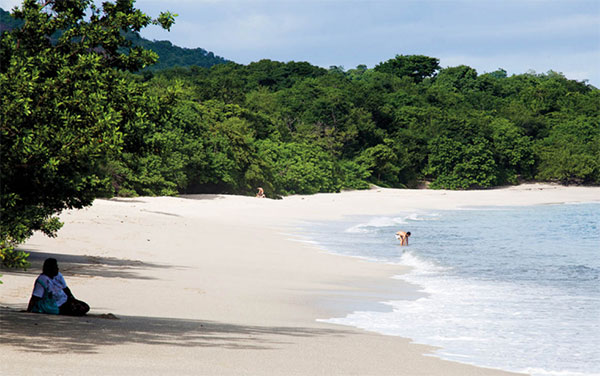Fact
The Guanacastecos, as the residents of this province are called, are self-reliant people. You may spot a bumper sticker on a local car, declaring (in Spanish, of course) ‘Thank God I was born in Guanacaste.’ Many are descended from the Chorotega people, an American Indian tribe who lived in the northwest during the Spanish conquest.
Puntarenas
Stretched along a narrow spit of sand – punta de arenas, or point of sand – Puntarenas ¤ [map] , the capital and the largest city of the province of Puntarenas, is the jumping-off spot for car ferries to the Southern Nicoya beaches. The growth of the Caribbean port of Limón and the more recent opening of the deep-water port at nearby Puerto Caldera put a major dent in the commercial viability of Puntarenas. Today, fishing is the main industry of Puntarenas and a visit to the busy fish market is the best entertainment in town.
Car ferries, as well as a smaller, passenger-only lancha (launch), cross from Puntarenas to Paquera on the Nicoya Peninsula. The one-hour trip across the gulf passes by 40 or so islands, including Isla San Lucas, Costa Rica’s former prison island which has an astonishing amount of biodiversity.
Papagayo to Playa Ocotal
The Papagayo Peninsula project is home to an 18-hole golf course and ultra-expensive hotels like the Four Seasons Costa Rica Resort (www.fourseasons.com/costarica) and the Andaz Peninsula Papagayo Resort (tel: 2690 1234; www.papagayo.andaz.hyatt.com), with more hotels and private villas planned. Around Playa Panamá ‹ [map] , half a dozen all-inclusive resorts are packed in the high season with budget-minded package travelers who rarely leave the manicured hotel grounds.

Playing in the surf at Playa Conchal.
Corrie Wingate/Apa Publications
To the south is Playa Hermosa › [map] , a sparkling half-moon cove with gentle surf. Despite some large-scale development at the northern end, this beach still has some charm and some excellent small restaurants and hotels. It is also a major diving center, with the long-established Sirenas Diving Costa Rica (www.sirenasdivingcostarica.com) based here.
Nearby Playas del Coco fi [map] is a working beach town with a large fishing fleet. The swimming isn’t great, but Coco is the launching point for myriad diving, surfing, and sport-fishing trips. The town itself has lots of character, albeit a little honky-tonk, with plenty of open-air bars, discos, and tacky souvenir stands. But there are also some excellent seafood restaurants to suit every price range. In town on the main street, Papagayo Seafood has reliably fresh seafood daily.
Just a couple of kilometers south of Coco lies dramatic Playa Ocotal fl [map] , a black-sand beach fringed with steep cliffs.
Playa Conchal to Playa Flamingo
Playa Conchal, once a deserted slice of beach composed of bottomless drifts of pink, orange, mauve, and sunset-colored seashells, lies just south of Flamingo. Although it is an ideal place to snorkel and beachcomb, the huge Westin Golf Resort & Spa looms over the beach, blocking access from the main road. But you can still reach the public beach by walking south for a kilometer (0.6 miles) along the shore from Brasilito, a bustling little town with a few interesting restaurants and the vintage Hotel Brasilito (www.brasilito.com), which has modest rooms in an old wooden building close to the beach. Good seafood restaurants here include El Camarón Dorado practically on the beach.
About 7km (4 miles) north of Brasilito you will find Playa Flamingo ‡ [map] , one of Costa Rica’s loveliest, longest, white-sand beaches.
Fact
The classic Costa Rican dish of gallo pinto (literally, painted rooster) is rice and black or red beans mixed with seasonings including onion, cilantro, garlic, and finely chopped bell peppers. The northwestern province of Guanacaste, formerly a part of Nicaragua, is the birthplace of the dish, so both countries claim its origins.
Playa Tamarindo area
From the Flamingo area, go through Brasilito to Huacas and continue for 13km (8 miles) south, where you will need to make a right turn for Playa Grande and Playa Tamarindo ° [map] , which was made famous by the classic 1960s surfer movie Endless Summer. Tamarindo does have a national wildlife refuge, though you would scarcely realize it. The wildlife seems more concentrated in the town’s many bars and clubs than it is in the nearby estuary. Some relatively inexpensive lodging is still available in the village of Tamarindo, where commercial centers and condominium developments have popped up everywhere over the past 10 years.
Parque Nacional Marino Las Baulas (daily 6am–6pm, night tours in turtle season; free during the day), which incorporates Playa Grande, was created in 1991 to protect the world’s most important leatherback turtle (la baula, in Spanish) hatching area, and was expanded in 1995. It was estimated at that time that there were only about 35,000 leatherbacks left in the world and approximately 900 of them came to Playa Grande to lay their eggs each year. Sadly, the population has subsequently fallen into a dramatic decline despite concerted efforts by the National Park Service and scientists to protect them.